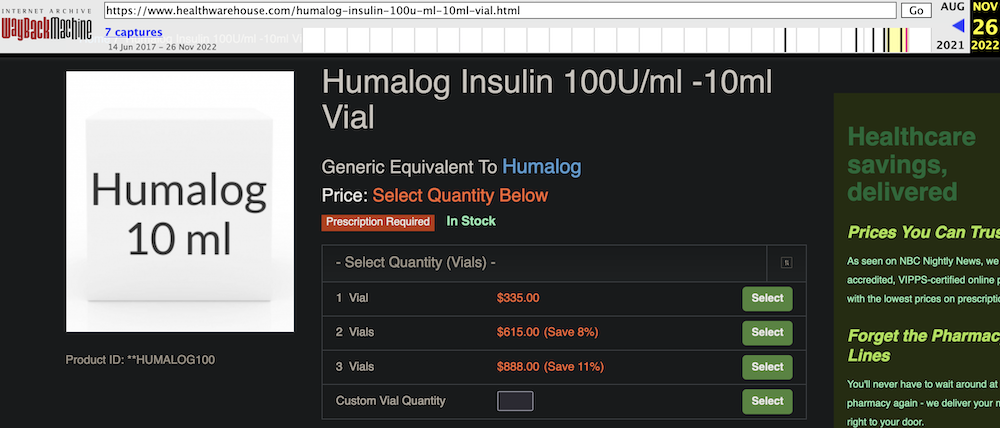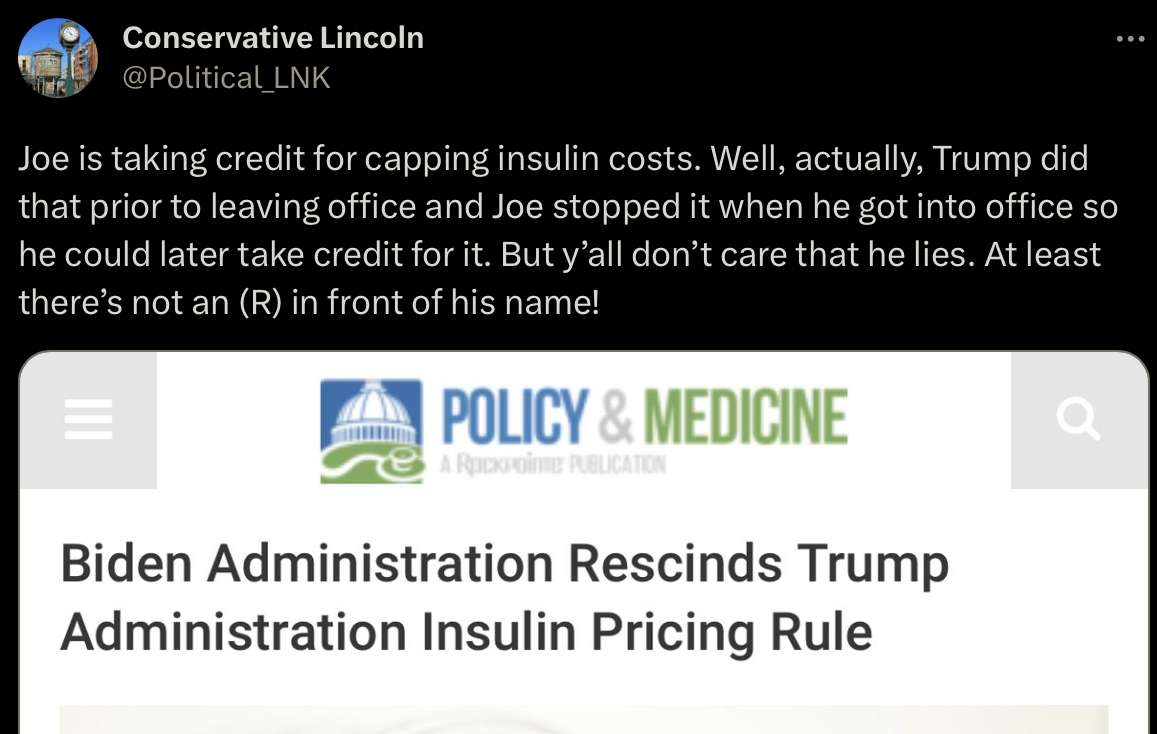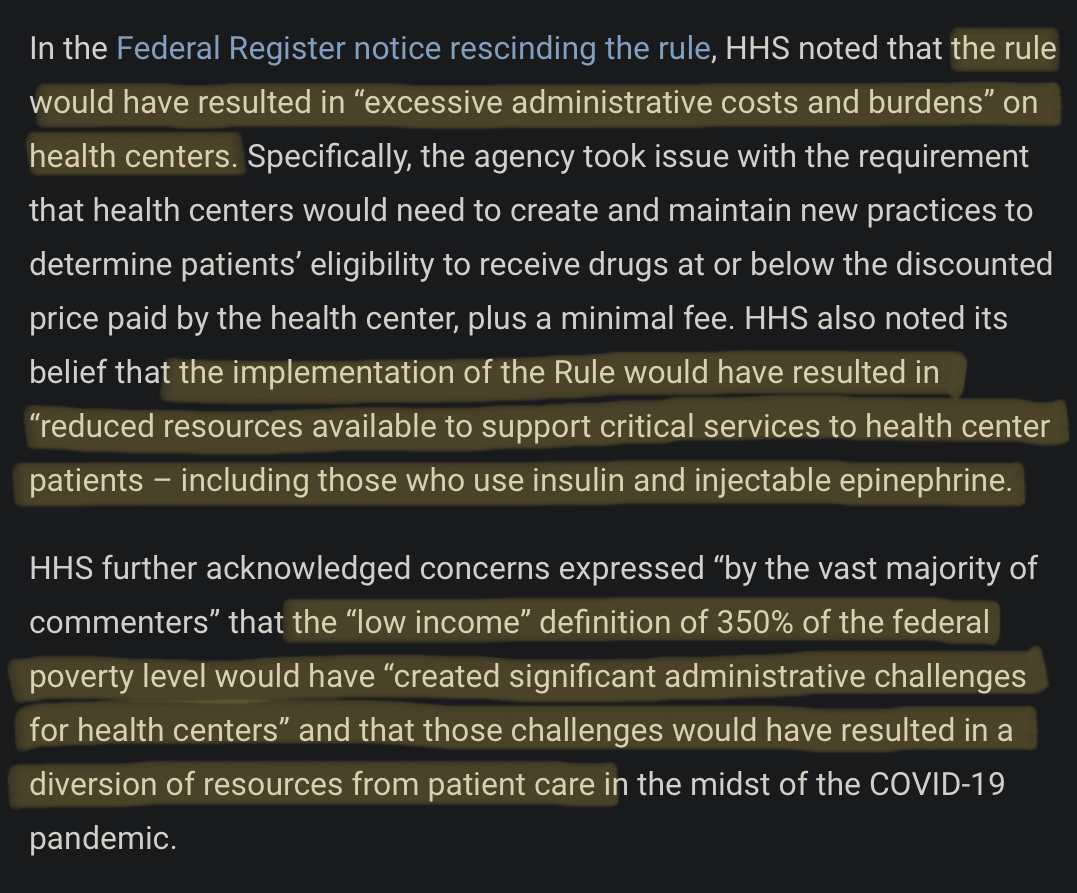Let's Set Trump's Insulin Pricing Record Straight
Except only slightly and for a token few, the former US president never reduced insulin prices, and the current president has never increased them.
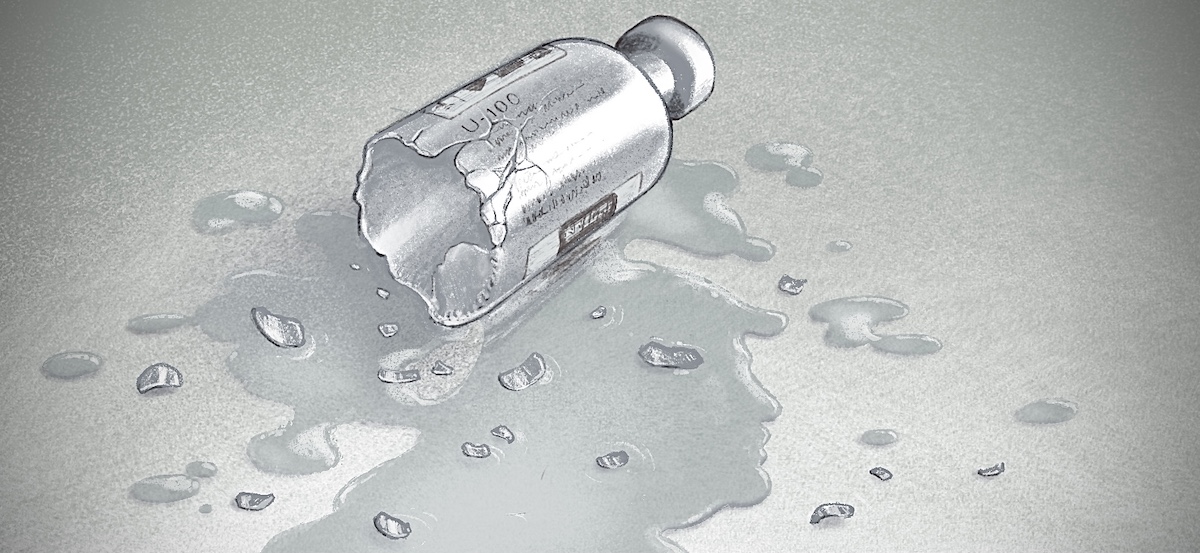
Nowadays it seems that around every 2-6 months a noticeable proportion of online discourse becomes briefly concerned with the price of insulin in the USA for at least one or two passes of the social media moon. The commotion over pharmaceuticals is often spurred on by the current US president's administration making an announcement/promotion concerning healthcare or when members of its Congress attempt to pass something to reduce the price of insulin for those of us who rely on it for daily survival.
Inevitably, a looming slab of the former president's fan-ship will troll related online conversations to share their belief that their champion had already reduced insulin prices while in office and his successor simply turned that all around on his first day in office. There are a few mostly incorrect versions and they often get crammed into one jumbled narrative.
 The common tale is that while in office, President Donald Trump lowered insulin prices for everyone, but after Joe Biden defeated him in the 2020 election, his administration reversed the reduction on his first day in office, making insulin prices super expensive all over again. Some renditions tell of how the ex-president lowered all insulin prices to $35 across the board. A few narratives utilize specious anecdotes of how their friend's cousin's co-worker's sister's kid's insulin was affordable under Trump until 2021, but now they are unfortunately back to paying through the roof for it. Others acknowledge the reality that it was just an unrelated Medicare rule that did not kick in until Trump was on his way out, but believe that Joe Biden is just taking all the credit for the former president's extraordinary deal-making to pull it off. And still others just smoosh it all together:
The common tale is that while in office, President Donald Trump lowered insulin prices for everyone, but after Joe Biden defeated him in the 2020 election, his administration reversed the reduction on his first day in office, making insulin prices super expensive all over again. Some renditions tell of how the ex-president lowered all insulin prices to $35 across the board. A few narratives utilize specious anecdotes of how their friend's cousin's co-worker's sister's kid's insulin was affordable under Trump until 2021, but now they are unfortunately back to paying through the roof for it. Others acknowledge the reality that it was just an unrelated Medicare rule that did not kick in until Trump was on his way out, but believe that Joe Biden is just taking all the credit for the former president's extraordinary deal-making to pull it off. And still others just smoosh it all together:
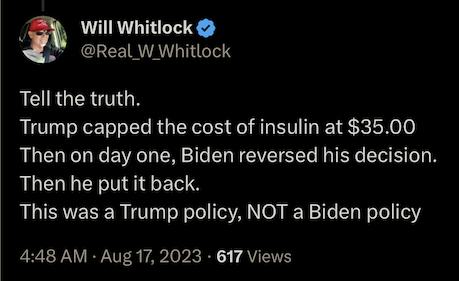 To be as crystal clear as a vial of humalog, we are not here to defend the current US president. We do not even have a go-kart in that political race. We do however have a type 1 diabetic here at the no name league. And if, despite current legal debacles, the next general electoral race comes down to a reenactment of the previous geriatric mud-fight, the issue of who did what for insulin prices will likely come up many more times before now and then in debates as well as the incoming avalanche of propaganda.
To be as crystal clear as a vial of humalog, we are not here to defend the current US president. We do not even have a go-kart in that political race. We do however have a type 1 diabetic here at the no name league. And if, despite current legal debacles, the next general electoral race comes down to a reenactment of the previous geriatric mud-fight, the issue of who did what for insulin prices will likely come up many more times before now and then in debates as well as the incoming avalanche of propaganda.
Diabetes is not a temporary disease. For type 2 diabetics who require it, insulin is a necessity that keeps blood sugars regulated when a pancreas can no longer keep up with the body's demand. It is not a walk-in-the-park, but with a great deal of focus and persistence there exists a possibility to reduce the reliance on insulin. Type 1 diabetics, however, are stuck with remaining dependent on insulin for the rest of their lives. Insulin has been a literal life-saver since its discovery, but there is no foreseeable way around access not being super-duper existential for Americans, considering each year more and more are diagnosed with diabetes.
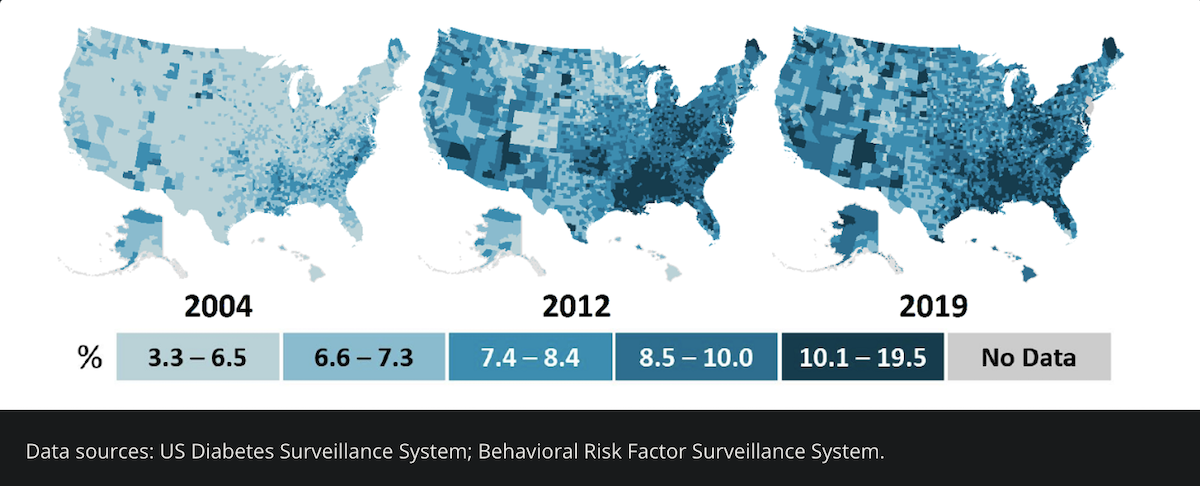 At minimum, those of us who care about the over 7 million insulin-dependent Americans with diabetes should be acquainted with the actual record of insulin pricing policies and not just rely on spin propagated by candidates and their fandom. We should be especially concerned with the significant number for whom insulin is an extreme financial burden of almost half their income.
At minimum, those of us who care about the over 7 million insulin-dependent Americans with diabetes should be acquainted with the actual record of insulin pricing policies and not just rely on spin propagated by candidates and their fandom. We should be especially concerned with the significant number for whom insulin is an extreme financial burden of almost half their income.
Like the current “trans-panic” turning into disingenuous momentary culture war induced concerns for women's sports and human trafficking victims (who are most often queer, minorities, and immigrants), the attention would be nice but diabetics are being used as insincere political fodder and it is, in fact, doing little to help. So today we are focusing specifically on the former president's record and how what little was done was never taken away by the president who replaced him.
An EO to hurt more than help
An executive order was signed by US President Donald Trump in July of 2020 that would not actually go into effect until Jan 22, 2021.
Its stated intent was to lower insulin and EpiPen prices for the low-income clients of Federally Qualified Health Centers (FQHCs). It also could be described as some marvelous window dressing...
The proposed Executive Order on Access to Affordable Life-Saving Medications would have barely budged the already modestly priced insulin for the patients at these community clinics. Yet, what it actually would do was add excessive red tape & burden to these federally supported health systems. And because no additional funding was appropriated in the executive order to support the extra resources & employees required, it would in turn create a reduction in services for the poverty-stricken.
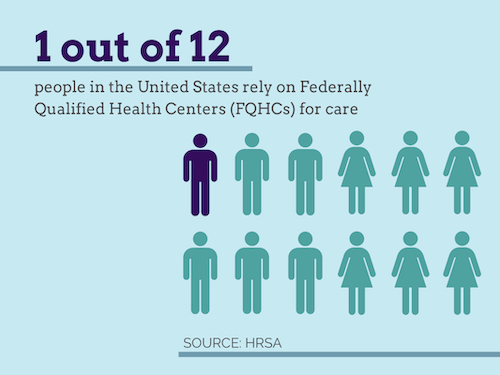 Specifically, the executive order (EO) we are discussing only affected Federally-purchased prescription drugs via the 340B program for community clinics, which is incredibly vital for poor diabetics & others to survive while they are scraping by.
Specifically, the executive order (EO) we are discussing only affected Federally-purchased prescription drugs via the 340B program for community clinics, which is incredibly vital for poor diabetics & others to survive while they are scraping by.
The 340B program was created by the US Congress in November 1992. For historical context, that would be right around the time that unforgettable bro-down went, uh... down.
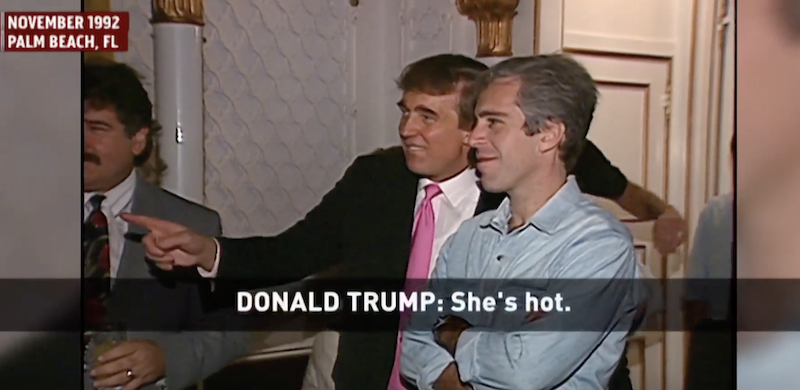 What the 340B and the EO have in common is neither affect insulin prices charged elsewhere, Because that is simply not how they work.
What the 340B and the EO have in common is neither affect insulin prices charged elsewhere, Because that is simply not how they work.
The nitty-gritty is that it would have reduced insulin prices by pretty much nothing for pretty much anyone. Certainly not down to $35.
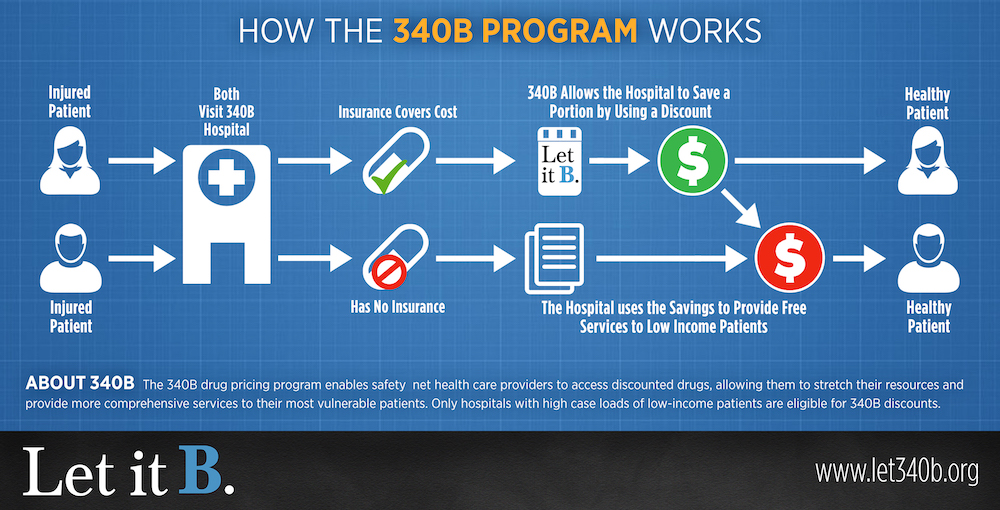 So before the EO took effect, it was rightfully delayed, then legally rescinded and taken off the table by the Department of Health & Human Services (HHS) by November of 2021.
So before the EO took effect, it was rightfully delayed, then legally rescinded and taken off the table by the Department of Health & Human Services (HHS) by November of 2021.
As in, the executive order that some point to as Trump's triumphant lowering of insulin prices, was never ever in effect. Not after it was signed in mid-2020. Not when it was scheduled to go in effect at the end of January 2021. And has never been since.
But how could an executive order be nullified?
Rescinding executive orders are not unheard of. Especially ones that will go into effect after a president leaves office. But agencies affected must first sort out if abrogation is legally justified. (The former president attempted this with DACA, but failed because “laws”.)
So the “Access” EO was patently trashed...
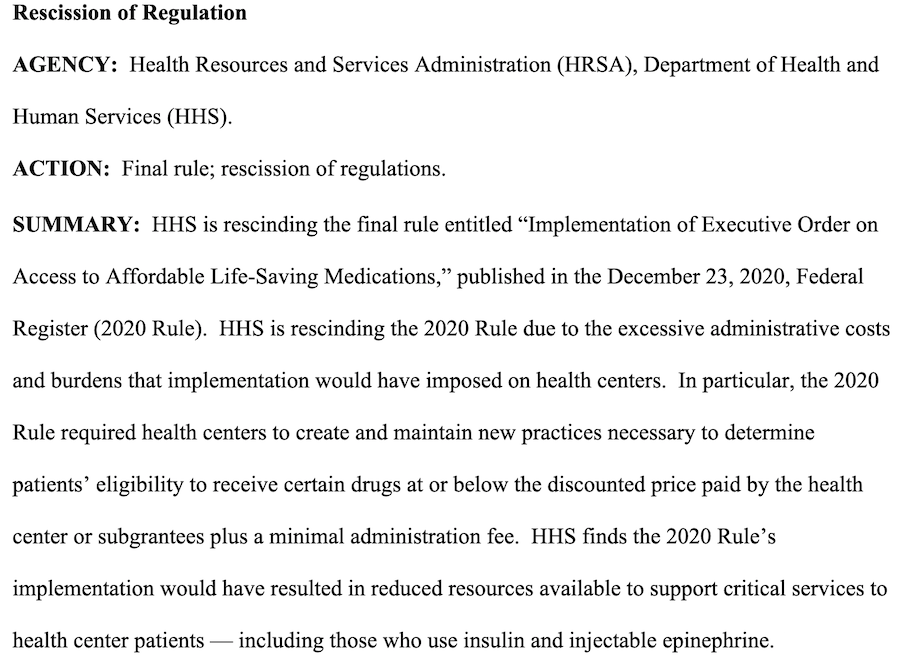 There are some finer details addressed later, but to state the obvious here:
this executive order was designed to sound good and helpful, yet once in full-swing would have only damaged critical health services for the poor.
There are some finer details addressed later, but to state the obvious here:
this executive order was designed to sound good and helpful, yet once in full-swing would have only damaged critical health services for the poor.
How intentional this was could be debated, but it is not the first underhanded attempts at dismantling health systems. As American's with their goldfish-y brains tend to do, most have already forgotten about the veterans who were suffering after Trump's privatization of the VA led to an “unmitigated disaster”.
So to those who still think insulin prices dropped precipitously under Trump and were driven back up after Biden entered office…
1. They simply did not.
2. You either live on a different timeline or have memory issues.
3. Screw you for making us seem like we are defending Joe Biden.
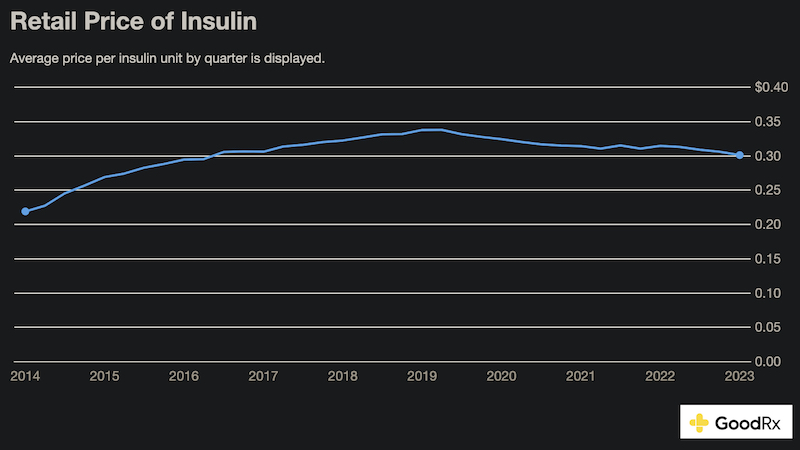 The social media posts of anecdotes about relatives & coworkers who supposedly had some atypical deal until Donald Trump left office start to sound rather dubious when one considers reality. If one really believes their insulin was cheaper under the previous president, then they should be able to easily provide receipts showing what they paid during his time in office. Or at least they would posses evidence of this imagined “cap” or price reduction under Trump, as well some proof of soaring insulin prices returning under Biden.
The social media posts of anecdotes about relatives & coworkers who supposedly had some atypical deal until Donald Trump left office start to sound rather dubious when one considers reality. If one really believes their insulin was cheaper under the previous president, then they should be able to easily provide receipts showing what they paid during his time in office. Or at least they would posses evidence of this imagined “cap” or price reduction under Trump, as well some proof of soaring insulin prices returning under Biden.
For the rest of us, we can check an online pharmacy to give us an idea of what pricing was like under Trump in August 2020 by using the ol' Wayback Machine:
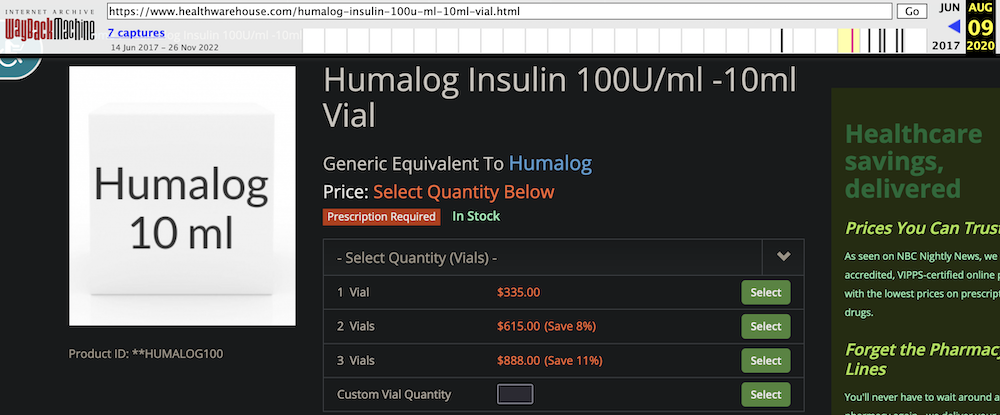
and under Biden in May of 2021:
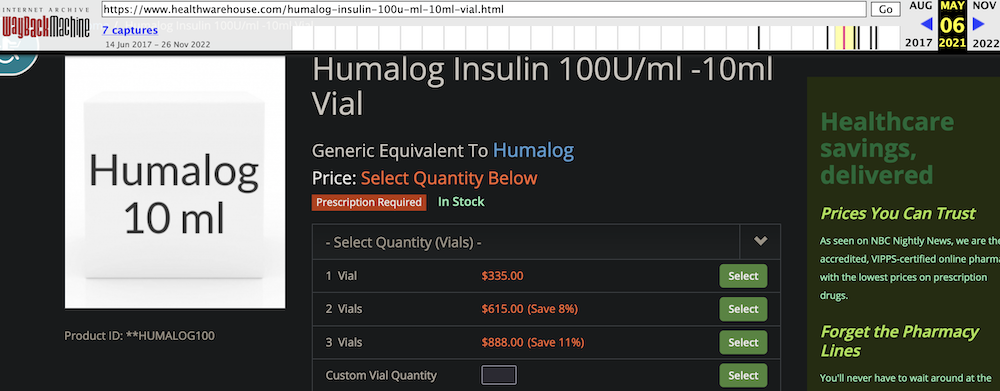
or one can even check it out for themselves:
www.healthwarehouse.com/humalog-insulin-100u-ml-10ml-vial.html
According to healthwarehouse.com's site, the price of insulin has remained expensive as ever for at least the last 3 years. Although it looks like they have finally increased their prices some in recent months, it remained the same at $335/vial from the end of Trump's term through almost all of Biden's thus far.
But if you somehow have those receipts hidden somewhere, please try not to be like this lady whose video made its way through online MAGA-land a few years ago with a goofy attempt at copying a poor mother whose clip of sheer frustration had gone viral on Tik Tok in 2020 for having substantial cost issues with her son's diabetic supplies.
To sum things up so far:
There was no executive order lowering insulin prices.
There was no discernible change to insulin prices for diabetics in the United States before or after the last president left office.
There was only an attempt at undermining health care resources for the poor and some silly antics abounded because of it.
Giving credit where credit is due...
Under the ex-president, the Centers for Medicare & Medicaid Services (CMS) added an optional $35 a month cap on insulin prices for those enrolled in Medicare Part D plans. The Part D Senior Savings Model was officially announced in May of 2020 and went into effect at the beginning of 2021.
But there are a few buts…
Medicare is generally for Americans 65+ years old (and some disabled people).
So if you are whining about losing a $35 cap on your kid’s insulin, that would mean that your child has been a senior citizen for a while now. Yes, this is a too common argument from people who do not seem to realize that would indicate that they are super old and probably should be enjoying their twilight years not fighting silly political scuffles online for their geriatric offspring.
Besides, the CMS's $35 cap did not kick in until January 1, 2021. That would be almost 2 months after Donald Trump lost his reelection campaign run and three weeks before Joe Biden replaced him in the White House.
As well, it only affected Medicare Part D plans, which has had relatively low prescription prices for a while. Part D is only available in premium Medicare (private/market) plans. Under the new CMS pricing model, the insulin price cap was a voluntary option that roughly a third of Part D plans adopted. At least 23% of Medicare enrollees in 2021 did not have the possibility to receive the $35 insulin cap because they were not enrolled in a Part D plan. In 2022, less than half (45%) of non-Low-Income-Subsidy Medicare recipients were on Part D plans that participated in the CMS's pricing model. (Nowadays, around 20% are without a Part D plan) That means that if the rule stood as it was in the waning days of Trump's presidency, at least 14 million diabetic seniors would not even have the option to receive the price cap.
Granted, maybe 3% of Medicare recipients use insulin.
So in theory, the best possible outcome was that the $35 optional rule applied to approximately 1.44 million, mostly type 2, diabetic seniors (20% of American insulin-using diabetics) if they were able to enroll in a Part D plan that offered the price cap. That is amiable, but not nearly as epic as the orange spray-tanned fanfare has tried to make it out be.
Another caveat to increasing enrollment in Part D plans is that prescription savings can be wiped out by the premiums charged by the insurance companies selling them. As well, while not his fault, Part D deductibles rose rather markedly under the former president:
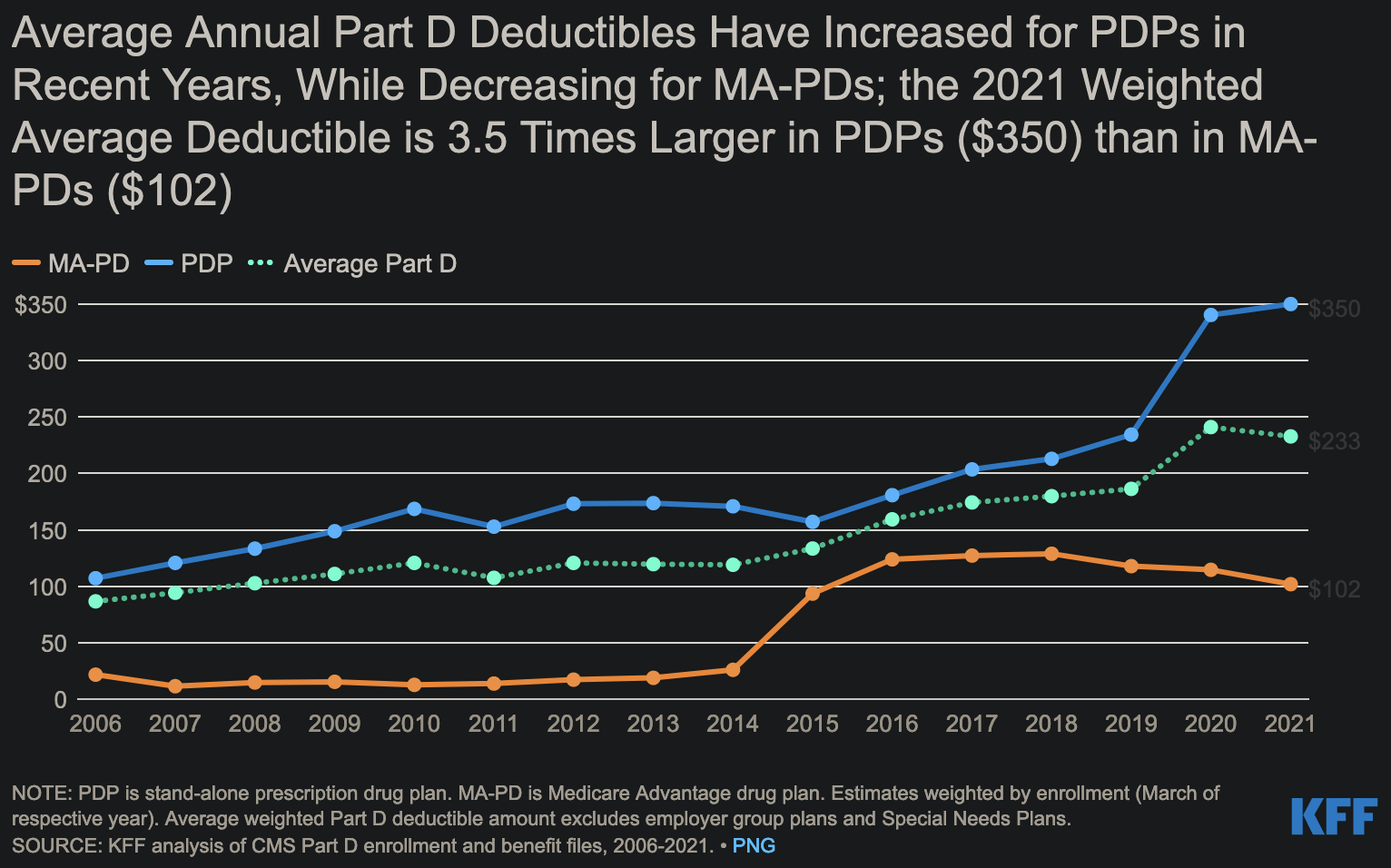
But the thing about the $35 is that it never went away
The Medicare Part D $35 insulin price cap has unceasingly been there since the first day of 2021 and has never not been a thing since.
If it had been removed, recalled, or rescinded, then we would be able to deftly dig up at least one press release from the White House, the CMS, or the HHS announcing it. There would also be some media coverage, especially in right-wing media blogs and their myriad of cable news channels. Similarly, we would be able to find a trail of fury across common social media platforms from Facebook and Twitter to the enclaves of Trump's fan-base on Truth Social, Gettr, Parler, Rumble, Gab, and Twitter (especially nowadays) over Biden snapping his fingers to overturn one of their champ's biggest wins.
As one of us is a diabetic, one would think we would have noticed that as well. Being current-events junkies, we definitely would have been aware of that transpiring. But we did not. And it is quite safe to assume that neither can anyone else.
Since the $35 insulin cap has existed since January 1, 2021 it has always been easily verifiable with a quick visit to Medicare’s own site. The $35 cap is mentioned right there in the middle of the page.
Sorry to poop the red-hat party, but it is very unambiguous that Biden did not make it go away.
Go ahead and click on the link to find out:
Hopping ourselves back into the Wayback Machine, we can follow Part D's $35 insulin progress through the captures of medicare.gov/coverage/insulin to find that it has always been there since the beginning of 2021.
While Trump was in office the page mentions the coming price cap:
 A few days after Biden came in:
A few days after Biden came in:
 Later in 2021:
Later in 2021:
 A year later:
A year later:
 And for good measure, here is 2023 after the IRA came into effect:
And for good measure, here is 2023 after the IRA came into effect:
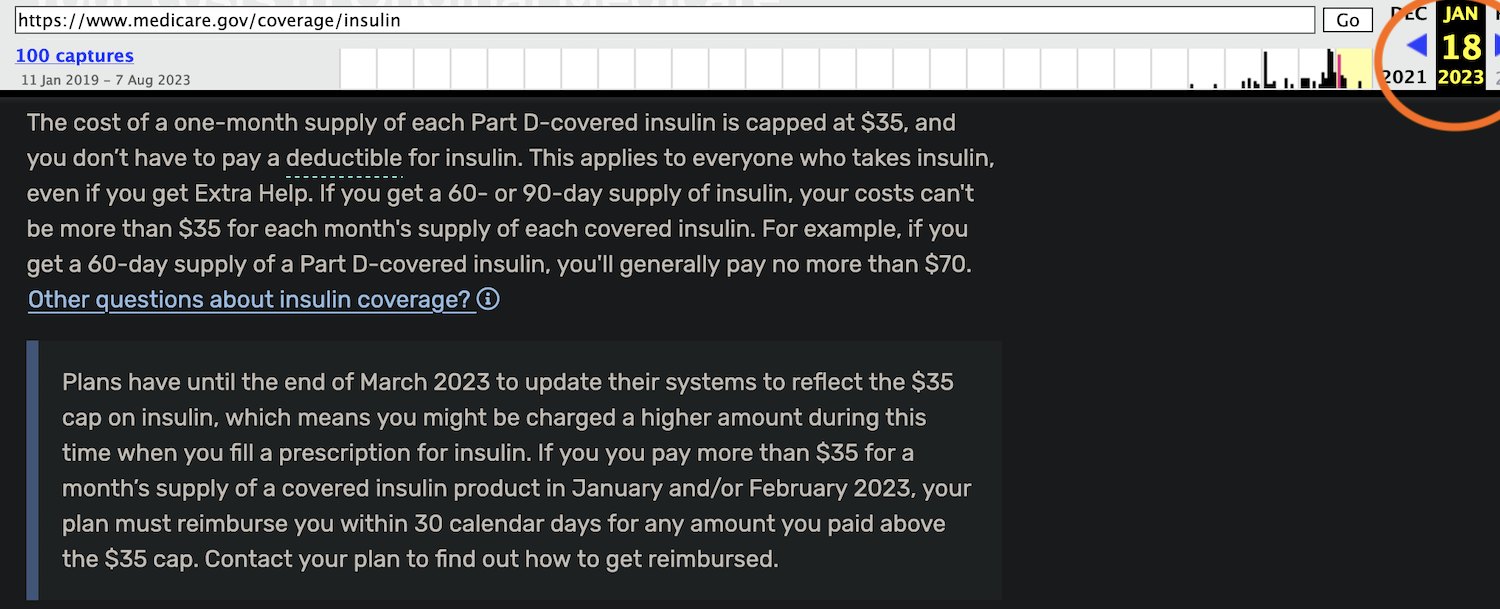 Honestly speaking, it is unclear how much he had to do with it, but kudos to the former president for occupying the office to initialize an insulin cap for diabetic American seniors. But again, despite incoherent rantings about it having been taken away and causing insulin prices to rise back up, the Part D $35 insulin cap clearly never went anywhere since it was enacted.
Honestly speaking, it is unclear how much he had to do with it, but kudos to the former president for occupying the office to initialize an insulin cap for diabetic American seniors. But again, despite incoherent rantings about it having been taken away and causing insulin prices to rise back up, the Part D $35 insulin cap clearly never went anywhere since it was enacted.
So no matter how you slice it...
Insulin prices did not drop wildly under the former president. Nor did they shoot back up after Biden came in. Heck, other than the last three weeks of his presidency and only for a portion of senior citizens who many were already getting discounted pharmaceuticals, insulin prices were never lowered under Trump. It would necessitate more than a few dimensional portals and maybe a time machine to make that measure of magic happen. Unfortunately, none of us have anywhere near that kind of technology yet, not even the US government.
The fanboy narratives really need to be given up. It is rather awkward, even embarrassing, that some will fabricate stories about cheaper insulin to glorify a shyster who hired Alex Azar (a fellow wealthy butthead who oversaw the tripling of the price of their insulin as Eli Lilly CEO) to head the HHS.
For us that are affected by #diabetes, the more we think about it, the more disgusting all this becomes. It is incredibly frustrating to have people's health used for political pageantry. Maybe like something in the vein of the Hippocratic Oath, there should be a requirement for politicians to pledge that unless they are working to actually help the situation, they will not use our physical well-being for their political bullshit. The slight-of-hand crud that ends up hurting us absolutely does not help.
Not to say that people with other ailments are not hyper-aware of their situations, but type 1 diabetics genuinely know their shit because this is not a fucking hobby.
This is not a disease caused by “unhealthy living” or “poor eating habits”.
There is no choice given in the matter and once one is diagnosed with the condition, they must simply endure it for the rest of their lives.
Nevertheless, those of us with busted pancreases are very astute about any subject matter related to our survival and we share and communicate with each other… a lot.
So we would like to make a top-level of a request that you please quit it with the fairy tales and the gaslighting. It is not helping.
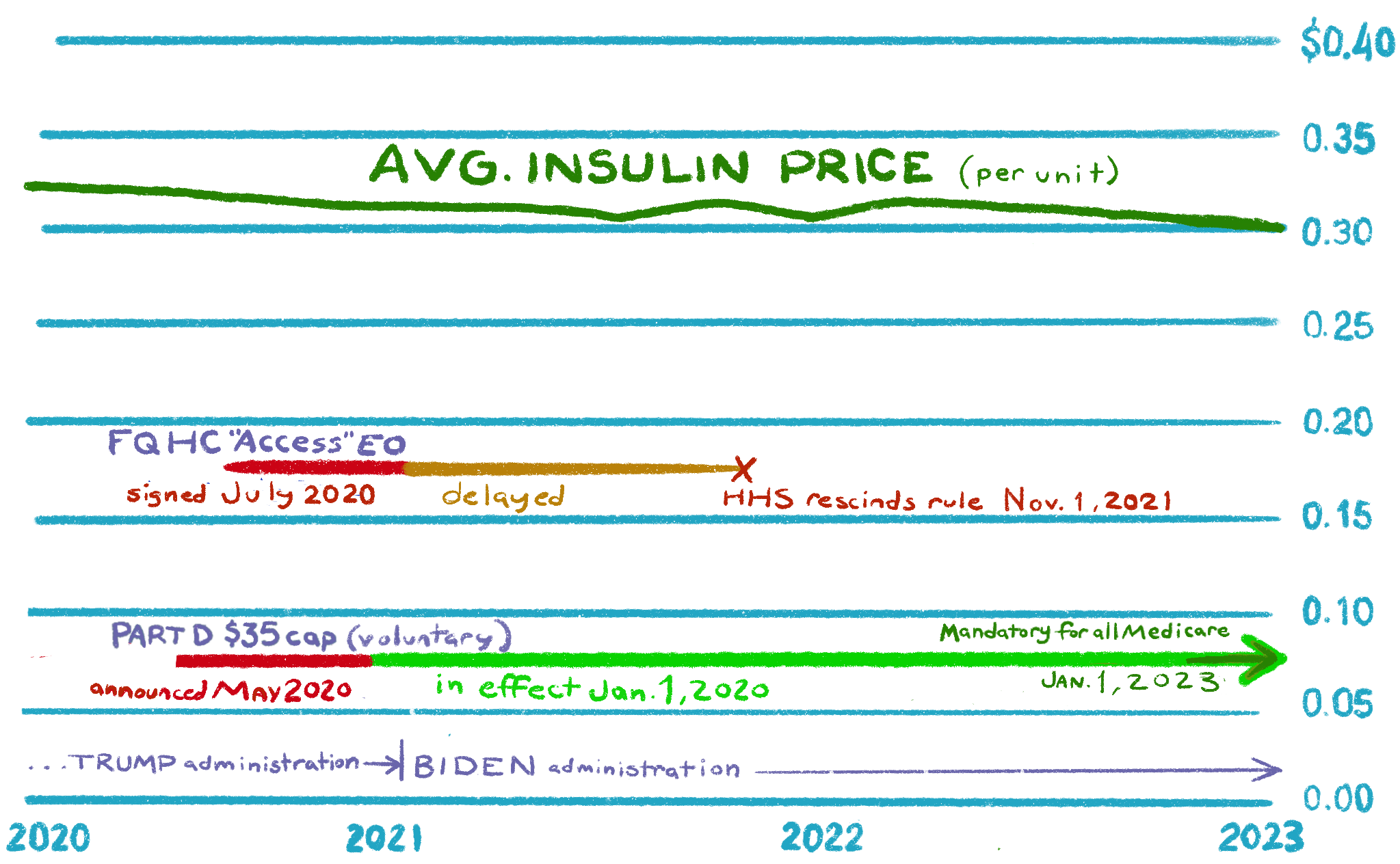
That was the gist of it. But if you are really into finicky bits...
There are some finer details, as well as some sigh-inducing arguments that get made by the online red-blooded red-voting red-hatted crowd that should probably be summarily addressed. Follow along as we work our way back to the top with our prototypical pedanticism.
Yes, Medicare is available to more than just seniors
As noted previously, Medicare is a federal health insurance program that those 65 or older qualify for. If you are hitting that age soon, this is your reminder that it is not automatic and you must enroll yourself.
There are also a handful of exceptions to the age eligibility requirement:
- Disability – If one receives Social Security Disability Insurance, they may be eligible for Medicare within 24 months. ALS sufferers are fast-tracked into Medicare.
- ESRD – If one has end stage renal disease, they are eligible after a kidney transplant or 3 months after dialysis treatment begins.
- Family relationship – In some instances, one may be eligible under the age of 65 based on their relationship with a Medicare recipient with disabilities.
- 62 years old – Benefits can be received slightly earlier than 65 if one meets the marriage and work requirements.
So now we all know that Medicare is mostly for seniors 65+, but it can also apply to some outliers. It is difficult to sort out exactly how many of those rely on insulin and would be eligible for the Part D $35 price cap after January 1, 2021, but as noted above, it is no where near the total number of insulin-dependent Americans.
Stretching FQHC services
Some fanboys point out that Trump's EO would have expanded the family FQHC coverage from the sliding 200% of the federal poverty level ($34,840) to 350% ($60,970). That certainly sounds great and of course would be wonderful if publicly funded health clinics were able to cover more Americans, but the EO would still not have increased funds for FQHCs to take on that extra load of clients and, as we have already revealed, in turn would limit the resources even further for everyone that needs to use FQHCs including those requiring insulin.
From the Rescission of “Implementation of Executive Order on Access to Affordable Life-Saving Medications” (2020 Rule):
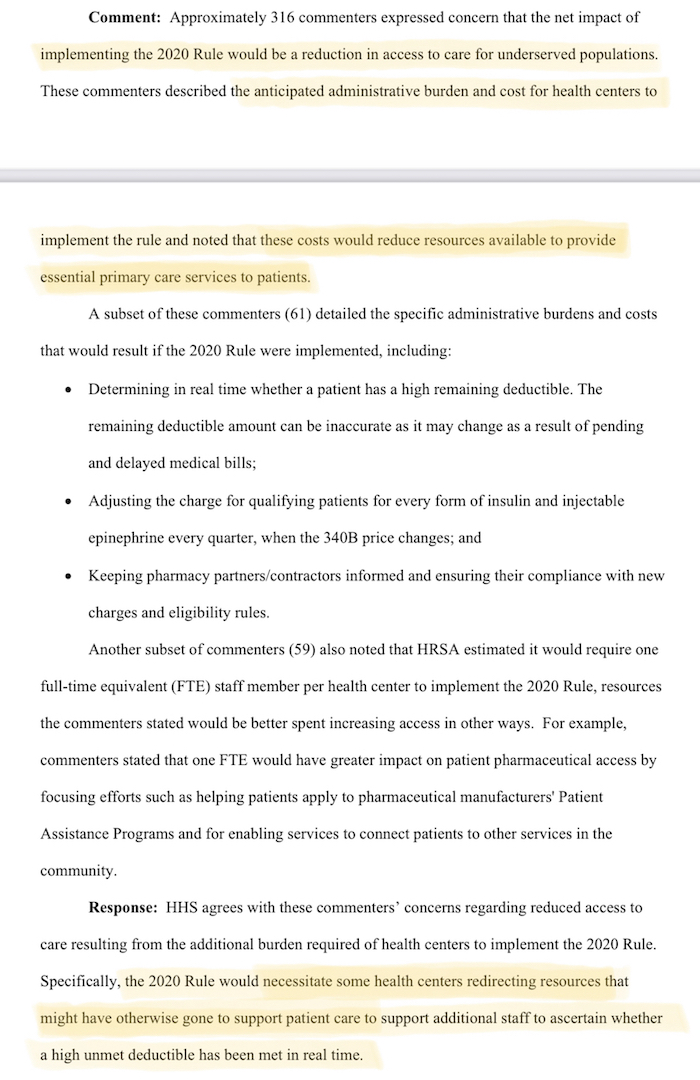
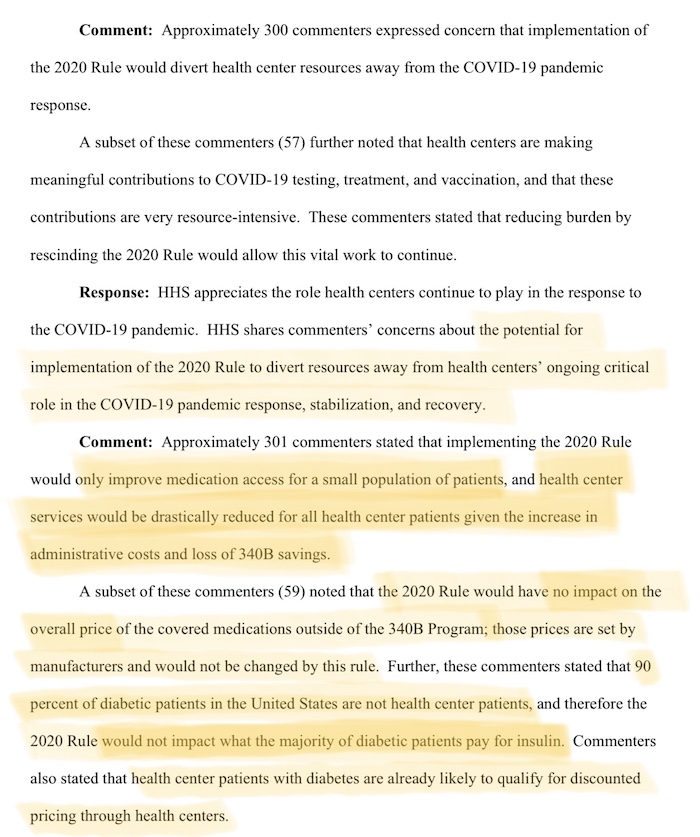 Additionally, because the proposed eligibility requirements differed from established federal guidelines, privacy issues would have arisen as a fleet of non-medical staff would be needed to deal with an influx of clients and to dive into their medical records to figure out which ones among them were eligible. (patient privacy issues would be an immediate inherent issue. maybe HIPAA suddenly no longer matters to MAGA anymore)
Additionally, because the proposed eligibility requirements differed from established federal guidelines, privacy issues would have arisen as a fleet of non-medical staff would be needed to deal with an influx of clients and to dive into their medical records to figure out which ones among them were eligible. (patient privacy issues would be an immediate inherent issue. maybe HIPAA suddenly no longer matters to MAGA anymore)
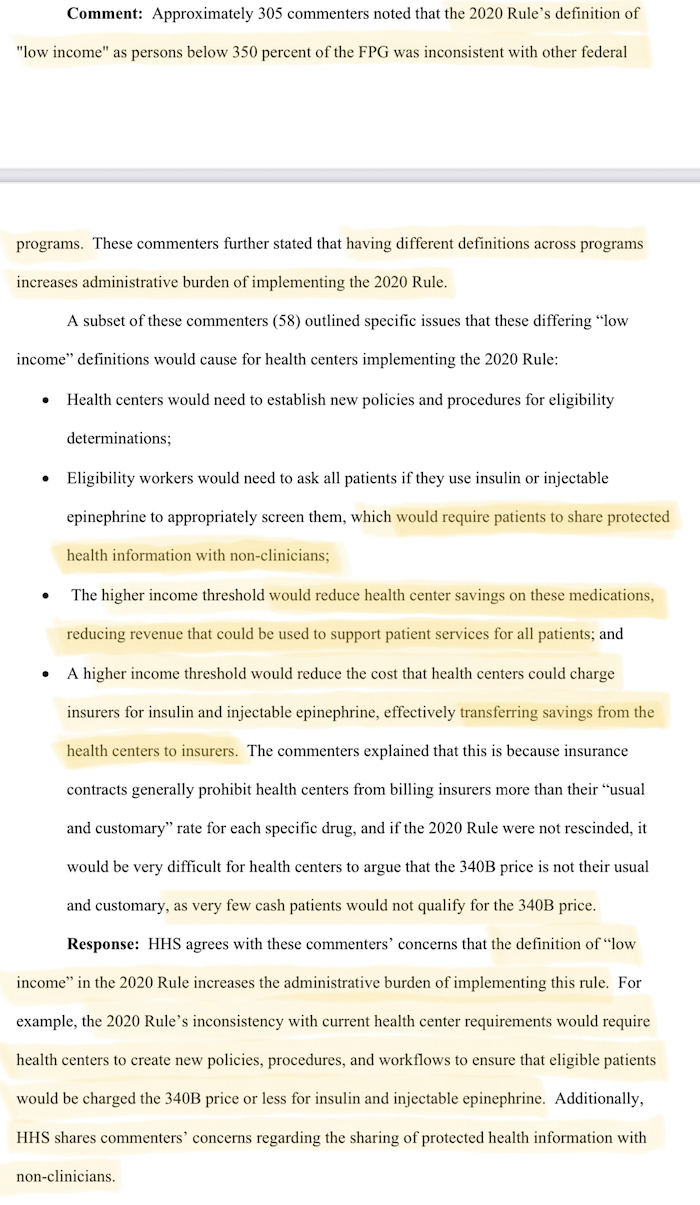
 Furthermore, recipients would not be able to show up at just any community health center to pick up insulin either. According to the rules, they would have to be regular clients at a specific FQHC to qualify. (so much for that ol' anti-ACA “They won't let us keep our doctors!” talk)
Furthermore, recipients would not be able to show up at just any community health center to pick up insulin either. According to the rules, they would have to be regular clients at a specific FQHC to qualify. (so much for that ol' anti-ACA “They won't let us keep our doctors!” talk)
Nevertheless, over & over the experts point out that the Executive Order on Access to Affordable Life-saving Medications would have only helped a rather small amount of diabetics by only a few cents at best. Namely because most of those dealing with poverty that would fall under the proposed FQHC rules were receiving cheap or free insulin already.
And we cannot stress this enough: without an increase of funding, clinics have no choice but to cut all sorts of service in order to keep up
...especially when they are in the middle of a global pandemic.
Importing more than just Canadian boner-pills
To pedantically cover all sorts of bases here:
In July of 2020, the former president signed an order allowing states, wholesalers, and pharmacies to import certain drugs from Canada and other foreign countries. It would have also allowed manufacturers to import lower-cost versions of the drugs they sell elsewhere as well. The importation/re-importation of insulin was also to be allowed.
This was originally labelled a “gimmick” by Azar, his HHS Secretary, but as any sycophant serving in that administration who wished to stay would, he changed his tune. He was not wrong though, as The Congressional Budget Office had already concluded that importation would hardly trim drug costs by an inconsequential 1% over the course of a decade.
There were also concerns whether medications would be safe for American consumption and if Canada even had enough of a supply to have much of an effect on US prices. And even worse for Canada, studies showed that a sudden increase in orders from the US would decimate their stock of drugs. If just one in five US prescriptions were filled by Canada, the country's drug supplies would be depleted in only 165 days.
Canada already was dealing with pharmaceutical supply issues during a pandemic. They were not about to let their situation get even more dire just so that their southern neigbhour could make a poorly conceived attempt at lowering prices.
Also, Canada does not have the resources to be the drug regulators for the US. Four in five online pharmacies claiming to be “Canadian” are actually from other countries and mostly sell drugs of questionable origin, safety, and efficacy. As Trump's Human Services Secretary Alex Azar stated:
So the Canadian government blocked bulk exports while Canadian drug distributors took the matter to court, effectively rendering the order mostly toothless.
Favored Nations
The Most Favored Nation Nation Price EO was signed in September of 2020 and the CMS subsequently announced in November of 2020 that the interim final rule was to take effect on January 1, 2021 alongside the Part D $35 rule and continue until 2027.
“Favored Nations” does not apply to insulin pricing, so we will stick to quick facts:
• It only would have specifically effected drug prices under Medicare Part B.
• It allowed the government to negotiate drug prices. (something the free-marketeers in his Republican base have taken issue with)
• CMS targeted 50 inject-able medications that made up the greatest amount of Part B spending. Insulin is not on that list. So anyone bringing the “Favored Nations pricing” is either naive or unscrupulous.
• There was only 5-weeks lead time, effectively cutting out recommendations from professionals and medical organizations that would be effected by the EO.
• The rule would have decreased access to medications and increased prices for a large number of seniors reliant on them for life-threatening conditions like cancer.
• The rule was blocked by a series of federal court cases before it could go into effect at the beginning of 2021.
• The rule was officially terminated by the CMS in January of 2022.
Again, we are just pointing this out to be thorough, but the IRA has comparable stipulations for the government to haggle over drug prices for Medicare Part B and D. Yet it judiciously skips the legal and detrimental hullabaloo because Congress and the current president did not just try to Hail Mary it at the end of their term.
Really confused arguments by really confused Americans
At this point it should be clear that people are mixing up different executive orders and various rules enacted before and after the ex-president left office. Most never went into effect and the one that did, still remained on the books and has recently been expanded to all Medicare recipients.
But we would like to say one last thing before getting into a few more examples of confusion and make some clarifications...
Universal Health Care would go a tremendously long way to fix this. No nation's health care system is perfect. Take the nation that looks like it is wearing the US for shorts and who the previous administration was hoping to fix drug pricing problem for them. Canada still lacks the political will to make insulin fully covered in every province, but at least everyone can get the insulin they need for free or less than $35 a month. Rationing insulin is unheard of in Canada. The richest country in the world (with the highest income inequalities of developed countries) could easily do something similar. It does not always have to be exceptional just to spite itself. Considering how the rest of the world does their health care, the US is exceptional
...but sadly, not all that often in a good way.
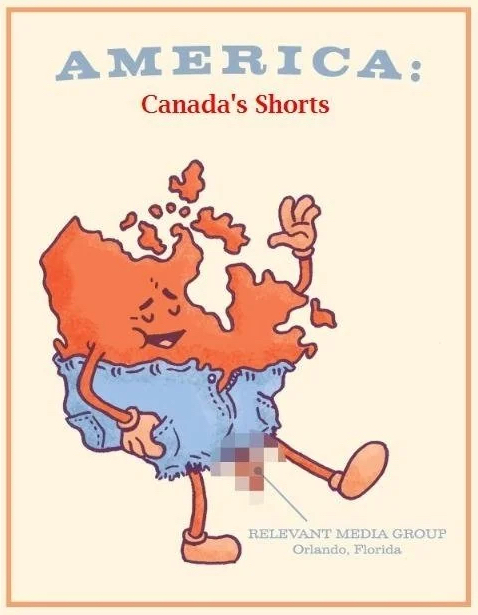
That said, we would like to show you a few of the sources/articles recurrently used as supposed evidence for “but #Trump lowered #insulin prices and #Biden reversed it” claims. These links also double as “further reading” resources if you need more to convince yourself or others that those assertions are entirely incorrect.
• Biden Administration Rescinds Trump Administration Insulin Pricing Rule – This is probably the most overused article seen on social media to “prove” that Biden broke what Trump fixed and made insulin prices shoot back up. There is a prolific problem with Americans reading headline without reading the actual words in the articles. The sharing of this report is made even more egregious because 9 times out of 10 the posts consist of a screenshot of the headline with the included image of a spilt jar of coins without providing a link or any assessment of its contents.
Although if one would take a moment to read it before posting it, they would find that the article is specifically about the FQHC rule that had never gone into effect. To be fair, although it does not mention the Part D rule, it is much more succinct than all this babbling done here and you would have saved time reading it instead. So we are just going to use a screenshot of a paragraph in the middle summarizing what has transpired with the EO...
It should also be pointed out that Joe Biden did not “rescind the order on day one” either. Again from the article:
The Biden Administration delayed the rule twice before it became effective on July 20, 2021, and the first opportunity for HHS to impose the requirements of the rule would have been through grants awarded in fiscal year 2022. So, while the rule has been in effect since July, it had yet to be implemented.
• Biden freeze hits two Trump drug price rules – This CNN article comes up quite a bit as well. Rather ironic given MAGA-land's disdain for the “Clinton News Network”. This essentially runs through what was rescinded and why. There is no mention of the $35 insulin pricing because it was never ended. And yet again, there is an explanation of why the FQHC order was on track to be rescinded, though:
• Joe Biden Rescinded a Trump Era Executive Order Capping Insulin Prices at 35 Dollars – We came across this blog post a few months ago hidden in the thicket of replies under a politician's tweet. It is not a well-known tract, but it illustrate the rationale that the ex-president's disciples seem to commonly hold.
As per usual, the blog's author conflates the EO with the optional $35 Part D rule, incorrectly implying that the Medicare rule was frozen:
...the Biden Administration froze all not-yet-implemented executive orders so they could undergo review.
Essentially that is a true statement, but the Medicare rule was already implemented on January 1 and was not an executive order.
The post continues on confusedly:
A large difference in the two plans is that the Trump Executive Order includes a provision for those without health insurance, and does not require the beneficiary to be enrolled in Medicare. Biden’s does not include any language for those without health insurance, and requires the beneficiary to be enrolled in Medicare.
Again, that is not an entirely wrong averment, but this is like comparing Apples to Cucumbers. The former president's EO applied to FQHC clients who would not generally be on Medicare in the first place. Similarly, the EO did not apply to those on Medicare. As explained almost endlessly in our article, the “large difference” was that the EO was a wholly different plan from the CMS's Part D rule (which also does not include any language for those without health insurance, yet requires the beneficiary to be enrolled in specific Medicare plans). Besides, that rule has recently been expanded as mandatory for all Medicare plans by the current president and has never removed.
One could maybe fault Biden for not giving the former president more credit for kicking off the Part D rule that he expanded, but as pointed out above, it is fairly difficult to confirm how much Trump deserves credit for it in the first place.
After previously explaining why the EO was rescinded, the blog continues by admitting that “Trump did not actually lower prices”, but then blames this on the Biden administration putting “a pause on the executive orders”.
As explained by expert after expert and this article that you are reading, the post's final statement, “If the Biden Administration hadn’t done that, then it of course would have gone into effect and reduced the prices”, is utterly false.
Besides, if both the Access FQHC EO and the $35 Part D cap were in effect, they would still not effect the overall prices that the vast majority of insulin-dependent diabetics pay.
Hopefully by now you have finally caught the drift
If you have gotten this far and are so inclined to keep reading even more in depth analysis by genuine experts, then have at the articles and studies below as well as the myriad of links provided throughout the article.
From those of us that have to deal with this illness on not just a daily, but on a minute to minute basis, please help us by at the very least informing yourselves.
• Access to Affordable Insulin and Epinephrine Autoinjectors Through Federally Qualified Health Centers – JAMA Network
• Trump’s $35 Insulin Plan: A Nickel Solution to a Billion-Dollar Problem
• Estimated Changes in Insulin Prices and Discounts After Entry of New Insulin Products, 2012-2019 – JAMA Network
• Insulin is an extreme financial burden for over 14% of Americans who use it
• Eli Lilly to cut insulin prices, cap costs at $35 for many people with diabetes – it is a start
• Yes, Biden stopped a Trump order to lower insulin costs, but it would not have helped most diabetics – short YouTube vid breaking down the Access EO if you are one of those “video watchers”
P.S. From those of us nerds who are tired enough of politicians & health systems dragging their feet that we are utilizing our DIY skills in order to help out our fellow hyperglycemia-prone laity, this must be emphatically expressed: #WeAreNotWaiting
(this was also published on Medium)
